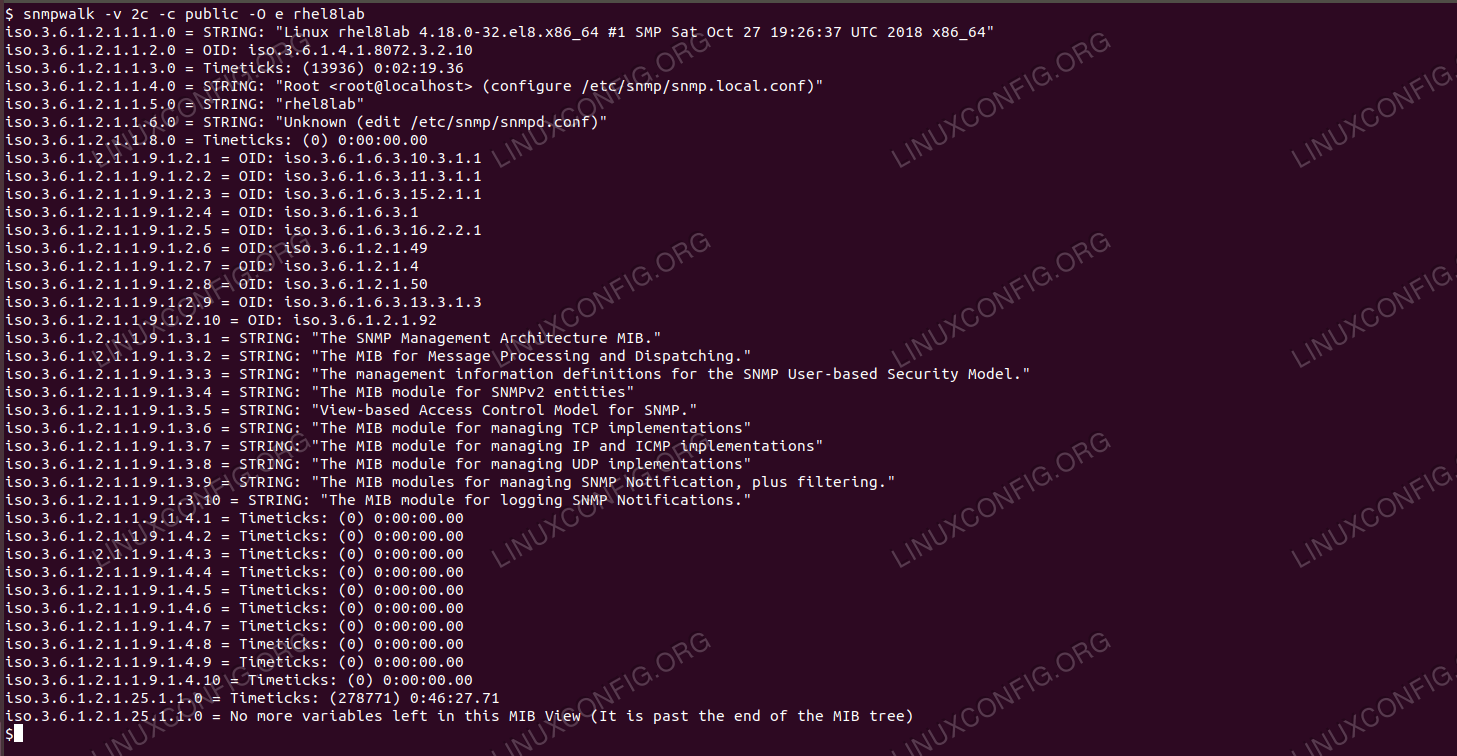
- #How to use snmpwalk how to#
- #How to use snmpwalk install#
- #How to use snmpwalk update#
- #How to use snmpwalk password#
We just provide minimum options to the snmpwalk. We will first look the simplest usage of the snmpwalk command. snmpwalk is a function provided by SNMP protocol to get metrics of remote system in bulk. Monitoring features are much popular than configuration.
#How to use snmpwalk install#
In short, we saw how our Support Techs install and configure SNMP on RHEL.SNMP protocol provides useful features to monitor and configure network and server systems remotely. Make note that to poll over SNMPv3, we must specify the username, the password, and the key. Then we start the service: # systemctl start snmpdĮventually, we try to poll the SNMP agent using snmpwalk.
#How to use snmpwalk password#
Once done, it will create a user with the specified password and key. The syntax of net-snmp-create-v3-user is: net-snmp-create-v3-user Then we can create a user: # net-snmp-create-v3-user -ro -A o2ps2w0dD -a SHA -X r30svV33 -x AES snmpuser To create a user for SNMPv3, we stop the snmpd daemon: # systemctl stop snmpd In order to configure SNMPv3, we create a user with a password, set an encryption password, access rights, and an encryption algorithm (MD5 or SHA). SNMPv3 is a newer and more secure version of the protocol with support for authentication and encryption. Since the remote server receives the information from the server over SNMP, we can add the server to any SNMP monitoring system.Ĭonfigure SNMPv3 on Linux CentOS/RHEL/Fedora In addition, on another server (install snmp tools prior to doing it) we run: # snmpwalk -v2c -c public 192.168.20.105 system We ensure that our SNMP agent is available remotely. SNMPv2-MIB::sysLocation.0 = STRING: GE-DC2 SNMPv2-MIB::sysObjectID.0 = OID: NET-SNMP-MIB::netSnmpAgentOIDs.10ĭISMAN-EVENT-MIB::sysUpTimeInstance = Timeticks: (106564) 0:17:45.64 We also query our server locally using: # snmpwalk -v2c -c public localhost system Since the service starts without any problems, but it is not working, we check everything specifically. We can fix this error by clearing the configuration file and adding only the lines specified above. Once we set the configuration file and run a test command, we may receive: Timeout: No Response from localhost If the SNMP configuration is correct, we will receive a set of SNMP data from the agent. We then check the service locally using the SMMPv2 protocol: # snmpwalk -v 2c -c public -O e 127.0.0.1 To poll the SNMP agent, we use the snmpwalk tool. # firewall-cmd –zone=public –add-port=162/tcp –permanent # firewall-cmd –zone=public –add-port=162/udp –permanent # firewall-cmd –zone=public –add-port=161/tcp –permanent To open SNMP ports in firewalld, we run: # firewall-cmd –zone=public –add-port=161/udp –permanent In case we use a firewall on the server, we allow connections to TCP/UDP ports 161 and 162. To ensure the service is running, we use: # systemctl status snmpd Then we enable the snmpd service and start it: # systemctl enable rvice Our Support Techs recommend entering a correct location and a valid email address. The above are three basic SNMP parameters.Įventually, we save the file. Here, we add the following lines: rocommunity public

Then we edit the SNMP agent settings: # nano /etc/snmp/nf Prior to SNMP configuration, we create a copy of the original config file: # mv /etc/snmp/nf /etc/snmp/ Then we install the SNMP agent and additional tools from the base repository: # dnf install net-snmp net-snmp-utils -y
#How to use snmpwalk update#
Install SNMP Agent and Diagnostic Tools on Linuxīefore we proceed with SNMP packages, we install the latest updates on the server using dnf (yum): # dnf update -y In addition, it does not require the installation of a separate monitoring system agent.

Its major advantage includes, it is supported by almost any device. For example, CPU utilization, the number of processes, state of services, etc.
#How to use snmpwalk how to#
Today, let us see how to install an SNMP (and SNMP v3) agent on a Linux host running CentOS, RHEL, or Fedora. We can use Simple Network Management Protocol (SNMP) to get information about the current status of servers, network equipment, printers, or other IP devices.Īs part of our Server Management Services, we assist our customers with several RHEL queries.

Wondering how to Install SNMP on RHEL? We can help you.


 0 kommentar(er)
0 kommentar(er)
